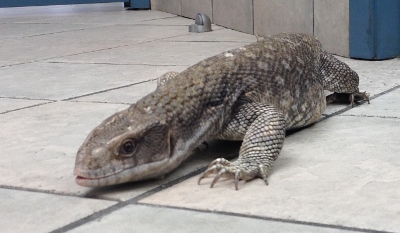
It’s time to bid the savannah monitor a fond farewell as our Animal of the Month now that it’s the last day of February. We hope you enjoyed following us on Twitter @ExoticPetVets this month as we tweeted all month about these fascinating lizards. But in case you missed any of our tweets, here is a summary. Did you know?:
- The savannah monitor (Varanus exanthematicus) is a lizard native to sub-Saharan Africa, north of the equator. Its range stretches from west and central Africa through to the area of southwestern Ethiopia and northwestern Kenya.
- The savannah monitor is also known as the tree leguaan or Bosc’s monitor lizard, after French scientist Louis Bosc who first described the lizard in 1792.
- Did you know that the savannah monitor is related to the komodo dragon, which is the largest lizard in the world? The komodo dragon is actually a type of monitor and is in same genus (Varanus) as the savannah monitor.
- As their name suggests, wild savannah monitors are found mostly in the African savannah, which is an open grassland sparsely populated by trees.
- Wild savannah monitors can also be found in some agricultural areas within the savannah belt. But they are not commonly found at elevations higher than 800 metres above sea level.
- Savannah monitors are stoutly built reptiles with wide heads, thick necks, long powerful tails and short muscular limbs.
- Adult savannah monitors can grow to a maximum length of 4.5 feet (1.3 metres) and have the capability to weigh up to 150 lbs (70 kg), but most weigh much less than that.
- Savannah monitors have thick skin with scales that look like flat pebbles. They are usually a dark tan or grey colour with lighter tan or grey bellies.
- In the wild, the main predators of savannah monitors include humans, birds of prey and large snakes.
- In some west African countries, savannah monitors are used in traditional medicine and hunted for food. Savannah monitors are also exploited in the pet trade and for their skin.
- In order to scare off predators, savannah monitors will hiss loudly and inflate their throats. They will also lash out against a threatening presence with their powerful tails.
- In the wild, savannah monitors live about 8-to-10 years. In captivity and with proper care, they can live between 15 and 20 years.
- In captivity, savannah monitors can be quite tame, but they need to be socialized consistently in order to become used to being handled by people.
- To tame a savannah monitor in captivity, it’s important to gently handle him when he’s young every day so he gets used to be handled and learns that his human family members aren’t a threat to him.

